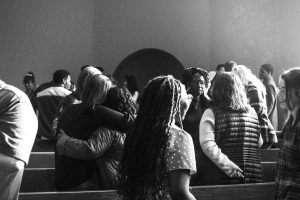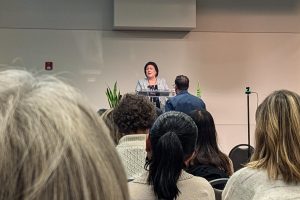Discussing second amendment, past and present
SPU’s News and Nachos series discusses current implications of right to bear arms
November 27, 2019
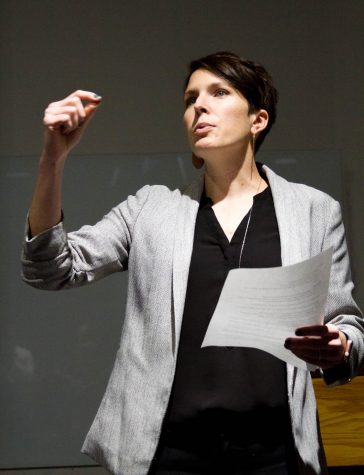
Professor Walter, Assistant Professor of History, introduces the 3 panels and gives a short introduction to gun violence in America.
“It is a topic all too prevalent today,” Dr. Karen Snedker said, addressing the News and Nachos discussion surrounding the Second Amendment and its contemporary implications.
On Thursday, Nov. 21 the last News and Nachos event of this quarter’s series took place in Demaray Hall. Three panelists gave responses to the questions posed by Dr. Alissa Walter surrounding Second Amendment and the right to bear arms.
Last year, Walter and her colleagues saw an opportunity to invite students to learn more about current events and kickstarted the News and Nachos series. It started off as professors in the history department talking about an event specific to their concentration of history.
Going into its second year, News and Nachos invites professors around campus to give different perspectives to specific issues, such as the Hong Kong protests or gender and family issues in South Korea.
“This series is to help us understand the world we live in today and help us put current events into historical context to figure out how we got here and what is the world we live in,” Walter said.
The three panelists, consisting of professor emeritus of history Dr. Bill Woodward, associate professor of political science Dr. Caleb Henry and professor of sociology Dr. Karen Snedker, gave their input on the current implications of the Second Amendment.
This human issue is sensitive to Seattle Pacific University following the 2014 shooting resulting in the death of student Paul Lee. The professors involved with News and Nachos respected this history, noting that gun violence is an issue that is close to home and needs to be discussed.
Woodward, a professor in the history department and a National Guard veteran, spoke on behalf of his experience and discussed the historical context of the Second Amendment.
“The preamble to the Second Amendment is referenced to a well-regulated militia,” Woodward said. “It was not how individuals might defend themselves … but rather how strong can a central
government be allowed to be without infringing the rights of the citizen?”
Woodward discussed the fact that the government is not the only supplier of guns, therefore significant steps will need to be taken to make way for revisions to the Second Amendment and its prevalence in today’s society.
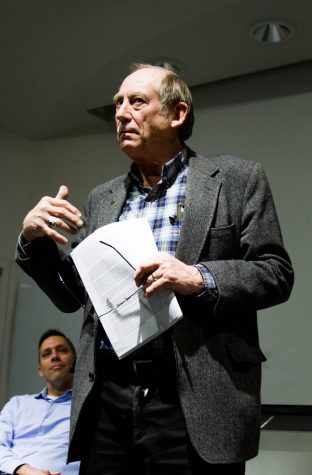
Henry, a political science professor, discussed the political nature of the Second Amendment and how it is understood today.
He recalled that conversations surrounding gun rights have been put into cultural terms and language that detracts from the lawful side of the amendment itself.
“If you are a rural moderate or rural conservative, you automatically see this as cultural conflict,” Henry said, alluding to the prevalence of guns in the rural American culture.
He stated that the issue is one of both cultural conflict and public policy, and he addressed the difficulty in having these conversations.
“Whenever you add culture and demographics to public policy it gets really, really difficult,” Henry said.
“At the end of the day, so much of our perception of these things are rooted in our culture and especially in polarizing environments.”
Snedker focused on the data surrounding guns and the American population’s current interpretation of the Second Amendment. She focused on the culture surrounding gun ownership and America’s mass exposure to guns.
“I think it’s important to think about the U.S. in the global world we live in … Guns are not just guns. Guns are about a lot of other things,” Snedker said. “Guns are about identity, masculinity and freedom and people’s interpretations of what it means to be American.”
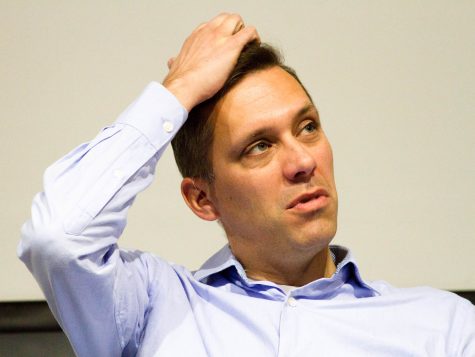
Snedker recalled statistics such as that four in 10 American adults report that they live in a household with a gun, 72% of American people have shot a gun before and 59% of Americans know someone who owns a gun.
The three panelists’ presentations were followed by a question and answer session facilitated by Walter. Students asked questions for further explanations or opinions from the professors.
“Do you think incentives to turn in guns would be effective?” Student Gracie Brown asked.
The three panelists went back and forth between one another with differing opinions.
Henry responded that it would not, reasoning that in today’s culture a gun buyback would “simply have no impact.”
Snedker followed him by saying that, “one of the common denominators is guns — so yes, if we had targeted programs, [they] would have to be smart in how they work it.”
For the rest of the questions, they did not settle on an answer but provided many perspectives furthering a discussion between the panelists and students.
Walter concluded the session thanking the audience for attending the final News and Nachos of the quarter.
Political science student Hannah Waterman discussed her view on the panels and what she was able to take away from it.
“I think that this issue is so multifaceted. The urban-rural divide shapes people’s perspectives so much that it can cloud other factors. I think just remembering that it’s a human issue and fear motivates us,” Waterman said.

















































































